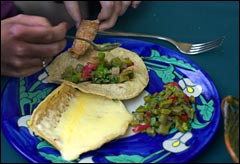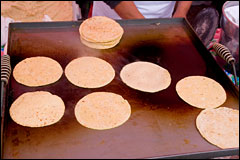In a spectacle similar to the one conjured up by the U.S. Supreme Court in 2000, a Mexican judiciary panel handed the nation’s presidency to Felipe Calderón last week. Even The New York Times, in its circumspect way, acknowledged that the new president-elect’s narrow victory over leftist rival Andrés Manuel López Obrador involved seemingly illegal activity by Calderón’s governmental and big-business supporters.

Classic Mexican cuisine is falling victim to crony-inflected neoliberalism.
Photo: iStockphoto
Calderón represents Mexico’s conservative National Action Party (PAN), which scuttled more than 70 years of one-party rule by defeating the Institutional Revolutionary Party (PRI) in the 2000 presidential election. But PAN candidate Vicente Fox’s victory that year, despite all of the international hoopla it generated, did not mark a fundamental shift in Mexico’s economic policy. Fox, a former Coca-Cola executive, essentially preserved the economic regime that had been instituted by the PRI in the mid-1980s.
Since that time, Mexico has generally hewn to the “neoliberal” economic line beloved of Wall Street and the International Monetary Fund: low taxes, tight monetary and fiscal policies, privatization of governmental enterprises, and a commitment to the free flow of capital and goods. To be sure, this agenda has been implemented with a dose of cronyism that might make Dick Cheney and his old Halliburton pals blush. But Wall Street has applauded the effort (save for its wrathful reaction to the nation’s severe financial crisis in 1994 and 1995); the Mexican stock market, 40 percent of whose shares are foreign-owned, has boomed since 1995. Over the same period, job growth has sputtered, and wages still hover at 1993 levels.
As the tens of millions of Mexicans, mostly poor and working-class, who bitterly oppose Calderón contemplate more of the same, it’s worth revisiting the important and largely forgotten story of how crony-inflected neoliberalism destroyed the quality of that iconic traditional staple, the tortilla — and how, in the process, local-food infrastructure, public health, and rural economies suffered while corporate profits fattened.
The People of the Corn
Archaeologists believe corn was first domesticated in Mexico’s Sierra Madre region around 3,000 B.C. At some point later, the Mesoamericans began transforming the grain into tortillas. “It is not known for how many millennia [tortillas have] been a staple,” writes Allan Davidson in The Oxford Companion to Food, “but when the conquistadores arrived in the New World in the late 15th century, they discovered that the inhabitants made flat corn breads.”
Until recently, the process for making tortillas had remained essentially constant over the centuries. In a technique known as nixtamalization, corn (hominy, not the sweet variety eaten off the cob) is simmered in water mixed with slaked lime. When the hulls loosen, they’re peeled off and the corn is ground into a dough called masa, which is then formed into flat rounds and cooked on a hot griddle. The result is a triumph of toasty corn flavor, and when wrapped around a stew made from dried chile peppers, it surely ranks as one of the treasures of world culinary culture.

Tortillas on the griddle.
Photo: iStockphoto
Tortillas remain a staple of the Mexican diet; the average person consumes 10 per day, and the country’s vast poor population relies on them for the bulk of their caloric intake. But since the early 1980s, the old process has undergone a rapid transformation.
Before that time, neighborhood- and village-scale tortillerias (artisanal tortilla factories) bought corn at subsidized prices and transformed it into tortillas; they also sold masa for home production. (In rural areas, smallholders made the tortillas they consumed from their homegrown corn, selling the excess grain into regional markets.) Now, however, most tortillas in Mexico are made not from fresh masa, but rather from processed rehydrated corn flour. And tortilla consumption is slowly falling, its place being taken by white bread.
Free-market champions tend to hail these developments as the result of free people pursuing their own choices unfettered by government control. In reality, though, large infusions of government cash and influence — not the market’s invisible hand — powered the industrial tortilla’s rapid rise.
All Hail the Tortilla King
In the late 1980s, a small corn-flour manufacturer called Maseca struggled to find a market for its product. The company fancied its processed flour to be a more efficient base for tortilla production than traditional masa. The problem, Anthony DePalma of The New York Times reported back in 1996, was taste: Mexican consumers overwhelmingly preferred the sweeter, more robust flavor of traditional, masa-based tortillas.
But Maseca’s chief owner, Roberto González Barrera, was a personal friend of Carlos Salinas, the Harvard-educated PRI finance minister who gained the presidency in 1988 on a platform of free-market reform. Widely thought to have stolen the election — a suspicion that has since been confirmed — Salinas nevertheless enjoyed fame in the U.S. financial media as a Gorbachev-like reformer. Meanwhile, he ran the state like a private fiefdom, doling out favors for his friends like a Kremlin hack.
González — and his unpopular product — counted among Salinas’ chief beneficiaries. Carlos Salinas’s brother Raul ran the federal agency that administered the government’s long-time tortilla-support program. Under the program — an effort to keep tortillas cheap while also keeping farmers and tortillarias in business — the agency bought corn from farmers at a subsidized price, and sold it to tortilla makers at a lower price. To make sure the tortilla makers passed the bargain on to consumers, the government put a price cap on tortillas.
Under Raul Salinas, the agency began to manipulate the tortilla program to favor Maseca. According to DePalma, in 1990 Raul Salinas’s agency “signed an accord with Mr. González in which the rules of the market were fundamentally changed. The agreement froze the amount of corn that would be given to traditional tortilla makers and declared that all growth in the market be filled by corn flour. At the time the only producers of corn flour were the government itself, and Maseca.”
Meanwhile, Maseca began offering to sell small tortilla makers equipment to switch from masa-based production to flour-based production — and the government provided extra incentive. As DePalma reported, “Those [tortilla makers] who refused [to buy Maseca’s equipment] were punished by the government, which sent them the worst corn and strictly limited the amount of grain the shops received. Hundreds of shops [went] out of business.”
As Maseca’s corn flour gained market share, the company began to grab an ever-greater portion of the government’s tortilla subsidies. By 1994, Maseca was drawing in $300 million in government cash — 43 percent of its total revenues, DePalma reported.
By 1996, Maseca had drawn the attention of Archer Daniels Midland, the world’s largest corn broker. Itself no stranger to government largesse, ADM spotted a good business model from across the border, and bought a 22 percent stake in GRUMA, Maseca’s parent company. Today, ADM’s formidable board chair G. Allen Andreas sits on GRUMA’s board of directors, as does the company’s CFO, Douglas J. Schmalz.
GRUMA now controls 70 percent of Mexico’s corn-flour market. As NAFTA opened the Mexican market to cheap, highly subsidized U.S. corn and dismantled Mexico’s support for its farmers, the price of corn in Mexico plunged, providing a windfall for GRUMA and despair for Mexican corn growers. Maseca now imports 30 percent of its corn for tortilla production from the United States, according to an Oxfam report [PDF].
And as the price of corn fell, the Mexican government — citing free-market dogma — withdrew its ceiling on the tortilla price. According to Oxfam, between 1994 and 2001, the corn price in Mexico fell by 70 percent; meanwhile, between 1994 and 1999, the price consumers paid for their staple, tortillas, rose threefold — further burnishing GRUMA’s bottom line. And when rising tortilla prices pushed many consumers to switch to white bread, GRUMA cashed in as well. Another of its subsidiaries — a joint venture with Archer Daniels Midland called Molinera de Mexico — is the nation’s largest wheat-flour producer, and GRUMA owns a fast-growing bread business as well.
GRUMA has also moved aggressively north into the U.S. tortilla market, and south into Central America. It is by far the world’s largest corn-flour and tortilla producer.
Thanks to his patrons in the Mexican political elite, GRUMA’s chief executive, Roberto González Barrera, now stands atop a global tortilla empire with annual sales of $2.4 billion. (Amazingly, he also controls a major Mexican bank, Banorte, which Carlos Salinas delivered to him amid perhaps the most disastrous bank-privatization scheme in history.)
Mexico’s citizens, for their part, have gotten a consolidated tortilla industry, more expensive tortillas, deteriorating health as people abandon traditional diets, and a rural economy that can no longer support its farmers.
As for tortillas themselves, according to my palate, the Maseca-based products that now proliferate throughout Mexico taste flat and dismal compared to the glorious masa-made tortillas that still flourish in some quarters of the nation. Generations of Mexicans will never taste them if Maseca’s chokehold on tortilla production continues.


